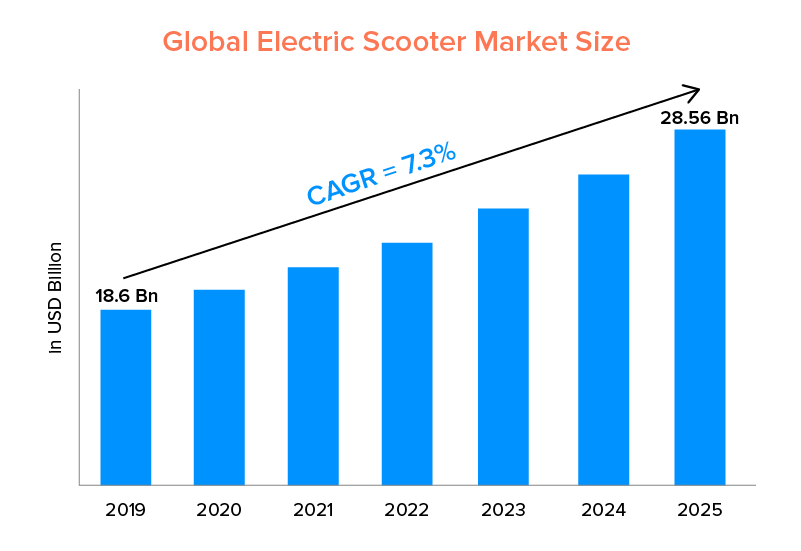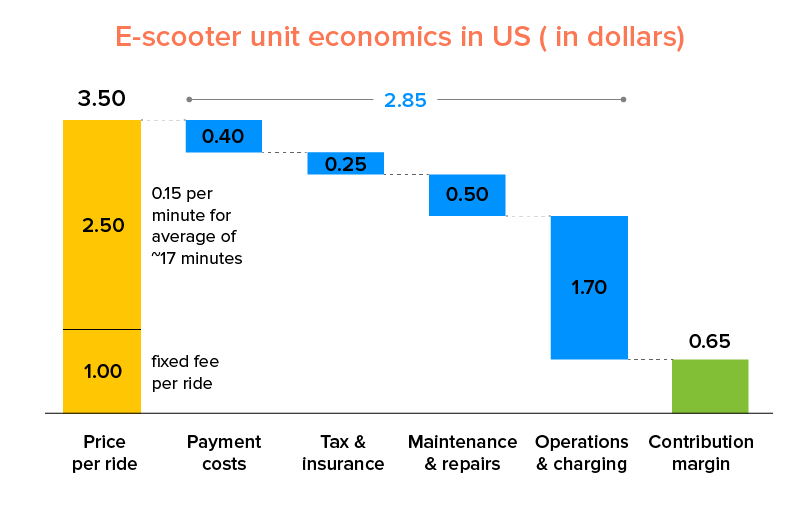Challenges to Know Before Starting E-scooter Rental Business
E-scooters have been in use for long enough to create different kinds of impressions in users’ minds.
Its progress is owed to its specific qualities and offerings it provides to its users and environment alike. The tremendous growth E-scooter rental and sharing industry has seen in the few years of its emergence is definitely commendable.
The global electric scooter sharing market size was evaluated at USD 18.6 billion in 2019 and is expected to become USD 28.56 billion by the year 2025 at a 7.3% CAGR. Now, this is something that is evidence enough of its prosperity.

Not to overstate but, according to Business Wire reports, the global market of E-scooter sharing is poised to grow by 2138.50 thousand units during the 2020-2024 forecast period, with showing a CAGR of 6%.
As of March 2020, E-scooter sharing services are collectively available in 177 US and European cities – something that shows that this industry has still not lost all of its winning cards.
Of course, every coin has two sides and this industry is not far from this saying.
The E-scooter-sharing industry unabashedly possesses the positives and negatives―the promises and the pitfalls―and keeps on improvising using technologies such as IoT, Machine Learning, etc.
For someone who is about to explore this realm and want to start a business, it is imperative to know the E-scooter start-up problems and opportunities in business they will be dealing with in the primitive stages and benefit from.
This is exactly what we will be going through in this article.
Electric scooter business challenges and opportunities
E-Scooter sharing market is promising but also uncertain
From the E-scooter statistics discussed above, it is pretty clear that the concept of shared-mobility is readily adopted by the public. For instance, only 15% of adults in the US ever used Uber in 2015 but the numbers rose by 2018 to 36%.
Moreover, BCG estimates that the global E-scooter rides shared market (amounting to $40 to $50 billion by 2025) will be equal to approx 15% of the overall size of the automotive-based on-demand mobility market of that year. Something which is a clear answer to many startup questions like “are electric scooters profitable?” or “are electric scooters the future?”.
There is still a high possibility of growth of the said market due to many factors. One of the best market opportunities for such short-range transportation systems is that E-scooters are still seen as a private mode of transportation and considered ideal for last-mile rides due to lesser costs than other on-demand mobility.
However ― Irrespective of such remarkable achievements and characteristics, the chances of mass adoption of E-scooters as one of the primary modes for on-demand mobility are still slim as a stick.
There are certain reasons for this too. For starters, there might not be adequate demand for this service, especially in sparsely populated cities, like with populations of less than 100,000. This can deeply affect any E-scooter startup business.
Another instance is where users might want to buy the E-scooter once and for all since they are not that heavy on the pocket.
Moreover, the sudden availability of E-scooters is known to procure mixed reactions from the users wrapped with a few concerns related to public safety, rules, parking, etc. These are some of the reasons why many cities are still skeptical about E-scooter sharing.
Higher profits are still a ‘to-be feat’
Besides the overall potential of profitability of this market, the unit economics is still something that makes electric scooter startup cry. It all ripples down to the quality and capability of the first generation of vehicles.
The average lifespan calculated for an E-scooter is only 3 months. These vehicles, as witnessed in many cities, become subject to vandalism, poor handling, and over-usage (since these were primarily made for private use and not as rentals) which consequently significantly diminishes their durability.
Still, besides the cost of an E-scooter itself, a company may take nearly four months at least to break even with the investment. This is when we put aside the marketing and other expenses.

The graph above is a breakdown of the unit economics of Bird E-scooter company.
Here is the evaluation-
Average per day revenue – $0.65 (per ride) x 5 rides (per day) = $3.25
Break-even time – $375 (average vehicle cost) ÷ $3.25 (per day contribution) = 115 days
Besides these expenses, there are other costs that need to be addressed such as transportation of E-scooters from the central facility for battery charging, maintenance, and repairs, followed by the redistribution the next day.
Nevertheless, improvements that are being implemented are going to significantly reduce these costs for good. For example, replaceable/swappable batteries will obviously eliminate this extra trip. Plus, there are many scooter manufacturers delivering robust E-scooters. In fact, some providers are already developing their own hardware to boost product durability.
Being a major contributor to the market share can be challenging
Given the popularity of this industry, there are several major players already dominating the market. Electric scooter-sharing companies like Lime, Bird (the pioneer of E-scooter sharing), JUMP (by user) are just a few names off the top. These also come under the category of top E-scooter apps which is a cherry on the top.
In fact, a dozen e scooter startups had already attracted fundings in the billions. Some of the recent funding bagged by the companies include Bolt with $30 million in series A, Voi with $85 million, and Tier with $40 million in series B round.
With so much competition already in the market, it is quite overwhelming for new businesses to acquire the user base and hence poses an Electric scooter-rental startup problem. Ipso facto, many E-scooter service providers and investors willingly sacrifice their early profitability in order to put a firm foot in the market.
One of the biggest obstacles here is that the offerings of these companies do not have much scope of differentiation. Regardless of the quality, users are likely to opt for the product easily or firstly available in their neighborhood.
Therefore, putting a reliable product on virtually every corner is all the marketing that companies need. However, over time, providers competing with others in the same location will need to set brand loyalty. This can only be done by focusing more on marketing and following practices such as promotional discounts to benefit customer acquisition costs while keeping the targeted electric scooter demographics in perspective.
Additionally, brainstorming to identify the niches in this industry and then coming up with innovative features in your e-scooter mobile app can create a huge positive impact on your business.
More so, the competitive spirit will not be restricted to the costs but will extend to acquiring more turf, i.e., capturing a wider radius of areas with E-scooter availability. However, this can very easily translate into losses due to poor asset utilization. Which in turn, along with other expenses like marketing, can create ghastly situations for a business in terms of increased costs.
Another of the probable challenges while starting an e scooter business is the monster of consolidation, i.e., acquisition. From the investors’ point of view, they might get a little skeptical as to whether the startup they are investing in will be able to stand in front of established competitors or not.
Steps not to be missed
There are certain maneuvers for E-scooter startups/providers to follow to become a leading figure in the market. Firstly, the daily operations of the electric scooter rental business have to be maintained and optimized. For example, maintaining, charging, and relocating processes for these assets is a major operational challenge, for which reducing costs to approx 50% of revenue will be required for profits to kick in.
Secondly, as we have also talked above, the durability of E-scooters along with improved battery life is a crucial aspect to consider.
Thirdly, startups need to strategize well for scalability and growth of the business. For this, they can establish partnerships with complementary service providers such as mobility sharing and ride-hailing companies. In fact, joining hands with public-transit firms at local and regional levels will also help boost e-scooter rental business’ growth.
Devising/adhering to regulation policies
E-scooter regulations will pertain to all the levels (local, state, and federal) regarding concerns such as road-side/footpath congestion.
Companies are also required to follow certain parameters set by the state such as the number of vehicles each company could deploy and provide data to the state to monitor, analyze, and eventually better plan for these services accordingly. Something that poses something that poses regulatory challenges for these electric scooter rental companies.
This sharing of data is crucial because the negligence towards the coordination between public transportation services, private mobility services, and use of public space (roads, sidewalks, curbs) can ripple down to lower efficiency and lesser safe roads since cities will fail to design these kinds of transportation-friendly streets.
On the customers’ part, the rider liability policies should be very detailed and marketed well to spread as much word as possible.
Finding the right partner – a reliable development company
While entering the on-demand E-scooter domain, choosing the right e scooter app development agency to develop an e-scooter app is something of a prominence. This is because the technology partner you choose today will shape the future of your E-scooter app. Moreover, your choice will affect the overall cost of E-scooter app development, depending on the location and the team size of that company.
Plus, the quality of your on-demand e-scooter app will also be at the mercy of the company you decide to make your technology partner. So, it should be a company that is trusted and reliable. However, the challenge is how to find such a company – something that we have covered in detail in our how-to guide for the E-scooter app business.
Not to be forward but Appinventiv is a well-known digital and mobility service provider company with expertise in offering services for various domains. Being a leading e scooter app development company globally, it is a reliable organization trusted by brands like Dominos.
Once you are through with these problems in business, your startup will definitely pick up speed to becoming a profitable and successful deal.

strategies your digital product..





